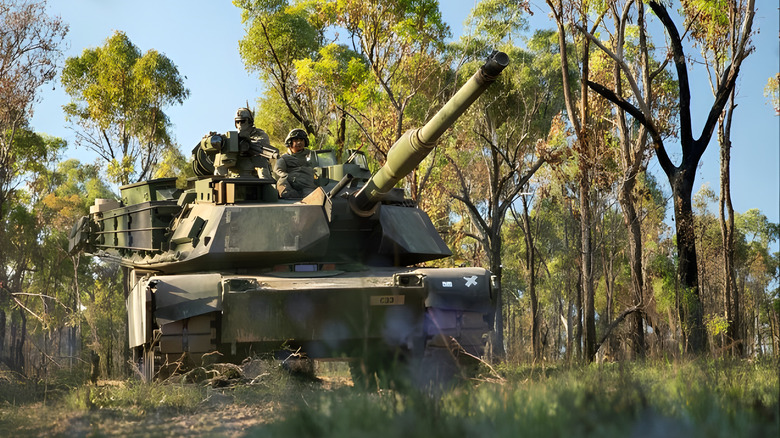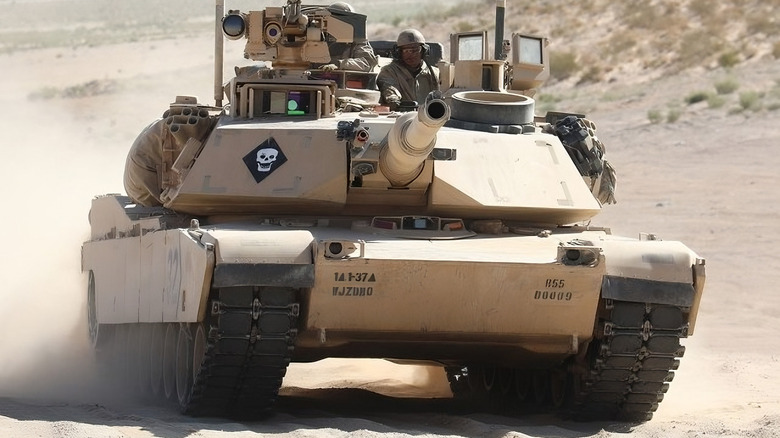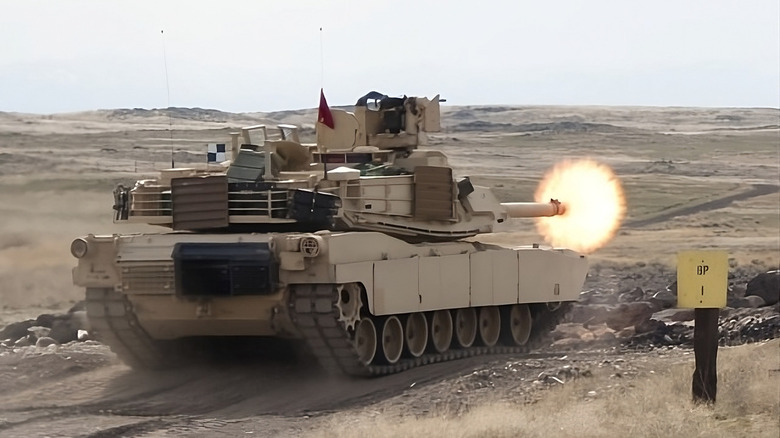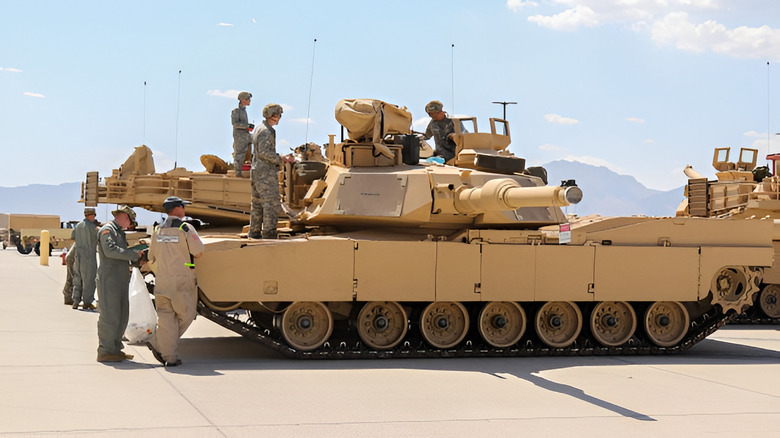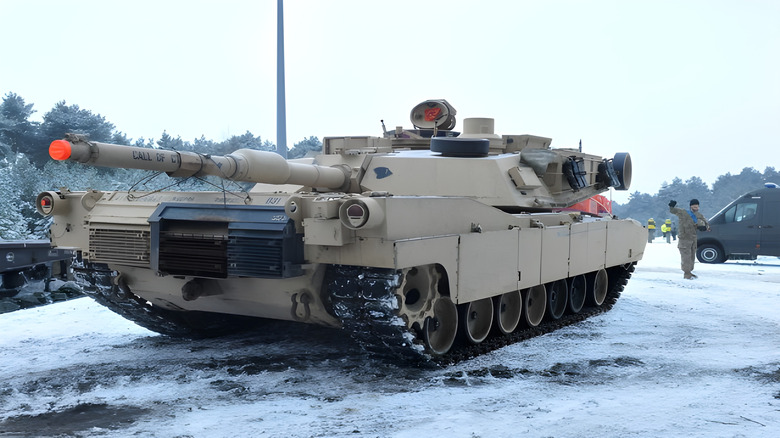This Formidable Battle Tank Is The Strongest One Used By The U.S. Military
Tanks have played an important role in U.S. military operations since World War I. But the tanks of that era can barely hold a candle to the advanced designs, capabilities, and firepower of modern battle tanks. According to Statista, the U.S. military has a fleet of 4,657 main battle tanks, giving it the fifth-largest tank fleet in the world.
Having such an arsenal is not cheap, but the investment assures that U.S. military tanks are at the cutting edge of military tech, capable of repelling any threat they may encounter. The conflict in Ukraine recently rekindled debate about the role of tanks in modern combat. While there are some who say that tanks are outdated given current anti-tank weapons and drones, others believe they are still necessary for establishing and holding authority in contested areas.
Whether tanks are useless in the modern age is a philosophical question, but for now, tanks remain a symbol of military strength and strategic advantage. Among the different models in the U.S. military arsenal, one stands out as the best in terms of strength and technology: the M1A2 Abrams. Here's what makes this formidable battle tank the strongest one used by the U.S. military.
It has a dominant operational history
The M1A2 belongs to a category of battle tanks that have been battle-tested in real-world conflicts, in addition to having an impressive spec sheet. The Iraq War, which began in 2003, was a major event that showcased M1A2's capabilities in both urban and open terrain fights. It did this by playing an important role in significant engagements like the Battle of Fallujah.
The tank's ability to survive improvised explosive devices (IEDs) and rocket-propelled grenades (RPGs) while remaining operationally effective was a boon to the tank's reputation. Although, it should be noted that they were not immune to damage from IEDs. However, despite the difficult urban fighting environment, the Abrams' sophisticated situational awareness systems gave the U.S. military a considerable tactical edge. Besides Iraq, the M1A2 hadn't really seen much action in conflict, but it has participated in training and partnership missions in countries like Poland and Lithuania. But iIts predecessor, the M1A1, saw a considerable amount of action in the Gulf War, Iraq, and Afghanistan.
It boasts advanced tech and firepower
There are a number of reasons why the M1 Abrams is considered ones of the best tank classes ever made, but firepower and tech has to be the biggest. Its primary weapon is the powerful 120mm smoothbore M256 gun. This armament can fire a wide range of ammunition, including the M829 armor-piercing fin-stabilized discarding sabot (APFSDS) and the M830 high-explosive anti-tank multipurpose (HEAT-MP) cartridge — extremely bad news for heavily armored vehicles and reinforced locations of the M1A2's enemy.
The M256 cannon, when combined with an onboard digital fire control computer with features like the Commander's Independent Thermal Viewer (CITV) and Gunner's Primary Sight, allow the tank to engage targets with pinpoint accuracy regardless of weather. These systems include thermal imaging, laser rangefinders, and computerized fire control systems, which work together to assure quick target acquisition and a high first-shot hit rate. Then there's the Inter-Vehicle Information System (IVIS) that improves situational awareness by allowing real-time data sharing.
In addition to the main gun, the Abrams is armed with a variety of secondary weapons, too. A 7.62mm M240 machine gun is mounted to the right of the main cannon, with another M240 machine gun on the hatch. The commander's station is equipped with a 12.7mm M2 Browning heavy machine gun, which features anti-personnel and anti-aircraft capabilities. We could stop there, and the M1A2 would still be the strongest battle tank used by the U.S. military, but the tank has another big advantage.
What is the M1A2's defense?
It is the most heavily armed tanks of all time, but the M1A2 is also one of the most heavily armored and fortified. The Abrams uses something called Chobham armor, which consists steel alloy and ceramic tiles in a metal frame. This style of armor is extremely effective against high-explosive anti-tank (HEAT) rounds. To max out the already high armor stats for the M1A2, it also has depleted uranium armor, which considerably improves its resistance to hostile fire, especially in the turret and frontal sections.
The M1 Abrams' defensive capabilities go beyond its armor, too. The tank is outfitted with reactive armor packages that detonate on impact, reducing the force of incoming projectiles before they can breach the primary armor. It also features separate containers for gasoline and ammunition. This compartmentalization assures that even if the tank's armor is breached, the chances of catastrophic explosions are considerably decreased, improving the crew survival odds.
Tech like CITV and IVIS are also technically part of the M1A2's defense. The M1 Abrams is also outfitted with a Missile Countermeasure Device (MCD), which destroys the guidance systems of incoming anti-tank missiles. Another part of the tank's defense system is its capacity to create a smokescreen with its M250 grenade launchers. Even after going through all these features, there's still much more that the M1A2 can do, possibly even more that are classified.
It has some weaknesses though
While the M1A2 is an overpowered battle tank, it does have a significant weakness — weight. The tank is approximately 32 feet long (including the cannon), 12 feet wide, and stands around 9.5 feet tall, and weighing around 63 tons — it's one of the largest military tanks ever built. All that armor takes a toll. The M1 Abrams' weight limits its mobility and is a big burden for military logistics. Transporting this mammoth of a tank to battle theaters requires significant infrastructure, including heavy-duty transport trucks and specialized rail and ships. The military also has to consider the fact that its weight may limit its operational range and maneuverability in certain terrains, especially in urban or highly forested areas where mobility is critical.
Luckily, the M1 Abrams has a strong engine that can actually manage this weight to a certain extent. The tank is driven by a gas turbine engine that generates 1,500 hp and can achieve speeds of up to 42 mph. That actually makes the M12A one of the fastest military tanks ever built, too. But having such a power plant that's basically a jet engine means extremely poor mpg. The consequence of all this is that the M1A2 is very expensive to operate and maintain. That's besides the already mind-blowing price tag of $19 million.
